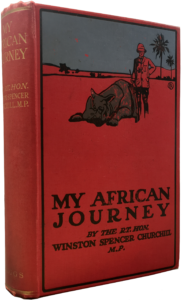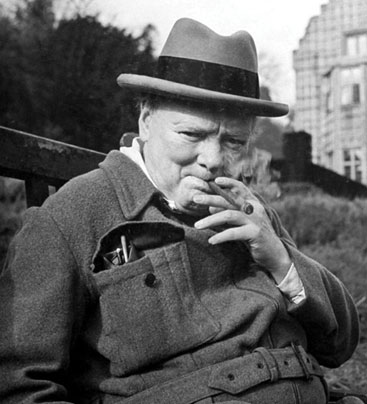CHURCHILL OUT OF HIBERNATION, WEEK 12
MY AFRICAN JOURNEY is a Churchillian travelogue documenting Churchill’s vacation scamper through East Africa in 1907.
We visit it next in our stroll through the book-length works of Winston Churchill.
 Within a year of Winston Churchill’s first Parliamentary election victory as a Liberal in 1906, his work on behalf of his new party had become so immense that Prime Minister Henry Campbell-Bannerman beseeched him to “mind his health” and “not overdo it.” Churchill responded in typical fashion by combining pleasure and business at once, embarking during Parliament’s summer recess of 1907 on a whirlwind tour of Britain’s colonial territories in East Africa, as the recently appointed Under-Secretary of State for the Colonies (his first official government office). En-route, Churchill attended military maneuvers in France, motored to Italy in a car loaned by his cousin Freddie Guest, hunted partridges and hares in Moravia, installed himself on Malta in the ancient palace of the Grand Masters of the Knights of Malta, proceeded to Cyprus in a naval cruiser supplied to him by the Admiralty, sailed on through the Suez Canal and arrived finally, at the end of October, in Mombasa.
Within a year of Winston Churchill’s first Parliamentary election victory as a Liberal in 1906, his work on behalf of his new party had become so immense that Prime Minister Henry Campbell-Bannerman beseeched him to “mind his health” and “not overdo it.” Churchill responded in typical fashion by combining pleasure and business at once, embarking during Parliament’s summer recess of 1907 on a whirlwind tour of Britain’s colonial territories in East Africa, as the recently appointed Under-Secretary of State for the Colonies (his first official government office). En-route, Churchill attended military maneuvers in France, motored to Italy in a car loaned by his cousin Freddie Guest, hunted partridges and hares in Moravia, installed himself on Malta in the ancient palace of the Grand Masters of the Knights of Malta, proceeded to Cyprus in a naval cruiser supplied to him by the Admiralty, sailed on through the Suez Canal and arrived finally, at the end of October, in Mombasa.
His ensuing East Africa safari was, of course, dominated by the hunt. He shipped a disconcerting quantity of skins back to London’s leading taxidermist, Rowland Ward of Piccadilly, who mounted a rhinoceros, a zebra, a wildebeest, gazelles, and a warthog, among others, for Mr. Churchill.
Upon reaching Nairobi, Churchill accepted an offer from The Strand Magazine for five articles detailing his peregrinations at £150 per article, with a further £500 offered for the rights to collect the pieces into a book. His travel expenses were thus defrayed in a wink, parlaying what had been a fact-finding mission and a safari expedition into another major new literary enterprise.
Published in December 1908, My African Journey proved a great success, with an initial print run of 12,500 copies. Read today, it is an exceptionally entertaining, if ecologically quixotic book, full of natural wonder brilliantly described; full of blood, and at least one slaughtered white rhinoceros; full of native tribesmen “tamed;” full of Churchill’s flaws as a figure of his time and place, but capturing that time and place with a timeless gift.
We wish you continued health and safety, as ever, and many timeless gifts captured.


